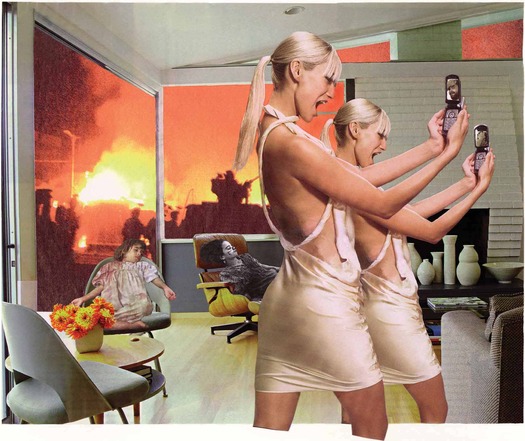Collage Culture: Nostalgia and Critique
Link to article.
 |
| Martha Rosler, Photo-op from House Beautiful: Bringing the War Home, New Series, collage, 2004 |
In his book Collage Culture: Readymades, Meaning, and the Age of Consumption, David Banash analyzes the origins and meanings of collage from a twentieth-century perspective. With an art historical lens, collage has often been a means of critiquing political or consumer culture. As collage continues to be used prevalently in the contemporary art world, its practice develops with a close relationship to this nostalgic source of meaning. In this article, journalism Rick Poynor interviews Banash regarding his approach to collage.
With a background in literature, Banash firmly believes that large concepts of philosophy, history, visual arts, the built environment, material culture, and media technologies should bind all studies in an interdisciplinary approach. Collage represents the perfect way to physically "cut apart and reassemble" different cultures, art practices, and relationships. The twentieth century and the prevalence of collage are perfectly intertwined in this way.
Collage is paradoxical. While it has the power to cut into ideologies and make them visible, it also "depends on the materials of consumer culture and quite literally re-enacts the exact processes of mass production and consumption." Collage can critique, but cannot escape consumer culture.
Poynor and Banash discussed digital culture's influence on the technique, observing the artists' tendency to rely on twentieth-century materials for their work, rather than online images. Without physical magazine images, there is no true cutting, mutilation, or dismembering of the spectacle.
This article is most interesting to me as it reveals the reality of media's cut-and-paste nature. As someone concerned with consumer culture, I think that the analysis of collage as a medium is both useful and inspiring. With digital media and art as a critical practice, I am constantly trying to see how the approach to my work can support the concepts behind it. As I look into different mediums and techniques, my field as an artist expands into a series of ways to implement my ideas more effectively and interestingly. Not only does this article give me insight into digital approaches to collage, but it also reminds me of the value of paper materials that I can take into the print studio. Banash describes nostalgia as "a desire for the past [which turns] our attention to what has been lost and holds onto it, keeps it from slipping away--which in the capitalist context of disposability can itself be a kind of resistance." Collage--digital or physical--reinvents material culture, transforming consumption into production. This article is useful in rethinking the digital approach to collage that we will take in Assignment 2. What is the significance of us using Photoshop rather than scissors and glue in Assignment 2? How does this influence the conceptual approach that we choose?

Comments
Post a Comment